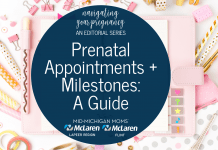This post shares one mom’s experience with Prodromal and Precipitous labor. Her knowledge comes from experience, as well as referencing the following sources: The American Pregnancy Association, The US Library of Medicine, National Institutes of Health, and Parents.com. This article was not written by a medical professional and should not be construed as offering medical advice.
When I became pregnant the first time around, I had rainbow-colored glasses on. I thought everything would be hearts, sparkles, and butterflies. Pretty much the average expectation of pregnancy, right? Ha!
Have you ever heard of Prodromal Labor? What about Precipitous Labor? Yup, me neither.
I did everything a first-time mom would do. I watched a ton of 16 & Pregnant and very graphic YouTube videos. I read parenting books, listened to podcasts, and even did the in-person birthing & breastfeeding classes.
Again, I thought I knew everything I had to know, heading into my delivery date. What else could I have done? I will be the first to tell you, I was wrong. I definitely did not know everything.
I had my birthing plan all set and ready to go. For example, I knew I was going to a hospital. I also knew that I was a hard-no on an epidural {moms that get one are so incredible in my eyes}. I knew that my husband would be with me {he can deliver a calf with his eyes closed, heck yes he would be there with me}. I knew that realistically I would most likely be in active labor for an average of eight hours {hello, ice chips, and hospital gowns}. I knew that I was in for the long haul. Coming into the home stretch, I thought I was prepared. Nope, I wasn’t.
Enter Prodromal and Precipitous labor.
Prodromal labor starts and stops before active labor begins, also known as “false labor.” Prodromal labor can come weeks, days, or hours before active labor starts. In my case, it was weeks, three long weeks of on and off contractions. These contractions are more intense than Braxton Hicks contractions are less than a minute in duration, and typically are relatively regular. Through all of this, I thought I had been experiencing Braxton Hicks contractions, but I am not so sure after doing more research. I am NOT an expert by any means, but it sure seems that the puzzle pieces fit.
Did you have Prodromal labor? In order to tell the difference between Prodromal labor and Braxton Hicks, you can ask yourself these questions: Where are you in your pregnancy? Typically Braxton Hicks can happen earlier in your pregnancy, whereas prodromal labor contractions happen within the last month. {Actually, fun fact, Braxton hicks can occur as early as six weeks into your pregnancy, but you can’t feel them.} Where is the pain located? Is it intense? Does it come and go? Braxton Hicks contractions are uterine contractions. What that means is that the pain should be isolated to the front of your abdomen and pelvis. The pain could come and go with movement, drinking water, and emptying your bladder. With Braxton hicks contractions, the pain will be weaker, like a menstrual cramp.
Prodromal labor is slightly different. The pain could start in the back and move to the front, like a real labor contraction. The key difference between the two is that the pain is not stationary. The pain will be more substantial, like real labor contractions, and there will be regularity in the contractions, but they can come and go over more extended periods of time. See why it’s called false labor? Finally, Braxton hicks contractions don’t tend to change your cervix. Prodromal labor can come with some changes. However, it is not uncommon for your cervix to be dilated, a centimeter or more, weeks before delivery. This dilation can happen due to a number of things, including where the baby is positioned. Checking dilation and effacement should only be done by your doctor or your midwife, not yourself.
The difference between the two can be hard for a first time mom to tell apart, even a seasoned mom. Heck, I am sure some doctors have a hard time. From personal experience, I am still not sure after this research and talking to my doctor.
What about Precipitous labor? Prodromal labor is also called rapid labor. In birthing class, I don’t even remember this being mentioned. With “normal” labor lasting 6-18 hours, rapid labor or Precipitous labor can last as little as 3 hours. These three hours consist of active labor and delivery of the baby and placenta. Just a reminder from class, active labor is when your contractions are regular and consistent, and your cervix has dilated to 6cm. As with anything childbirth-related, labor start time is subjective. For example, I consider my labor with my first to be less than three hours, once my water broke, and things finally got “real,” but I was having contractions for longer than that.
So, how can you tell you have rapid labor? Per the American Pregnancy Association, here are the signs; there is a sudden onset of close and intense contractions or an intense pain that could feel like one giant contraction. These contractions can be accompanied by the immediate sensation of pressure, including the urge to push. Rapid labor sounds terrific right? What happens if you’re far from the hospital? What about your emotional needs? What about the baby? Sure, being done with labor super quick is a huge plus, but feeling like everything is out of your control is strange.
I am relatively sure that I experienced both of these, and I wish I would have known about them sooner. I wish we talked about Prodromal and Precipitous labor as openly as we talk about the type of labor that lasts for days. I want I could have been prepared for the possibility that this could have happened to me.
Here is the thing about labor and delivery. You can have a plan, but you need to be willing to throw it out the window when it comes down to it. It is also good to know that every labor and delivery is different.
I attempted to find some research linking Prodromal labor and Precipitous labor; there is not much out there. But how can they not be related? It sure seems like they would be. Who knows? All I know is that if I can teach a soon-to-be or seasoned mom about this and help prepare them, I am thankful.
Has this happened to you? I would love to hear your story!

















This happened to me too!